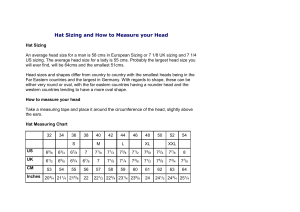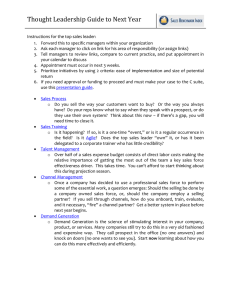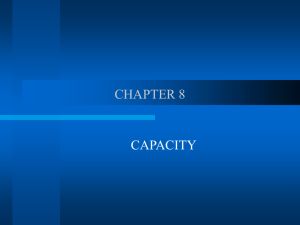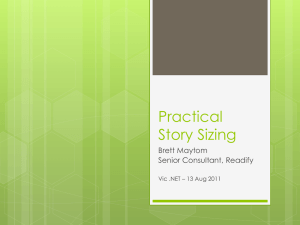Use Case Sizing
advertisement
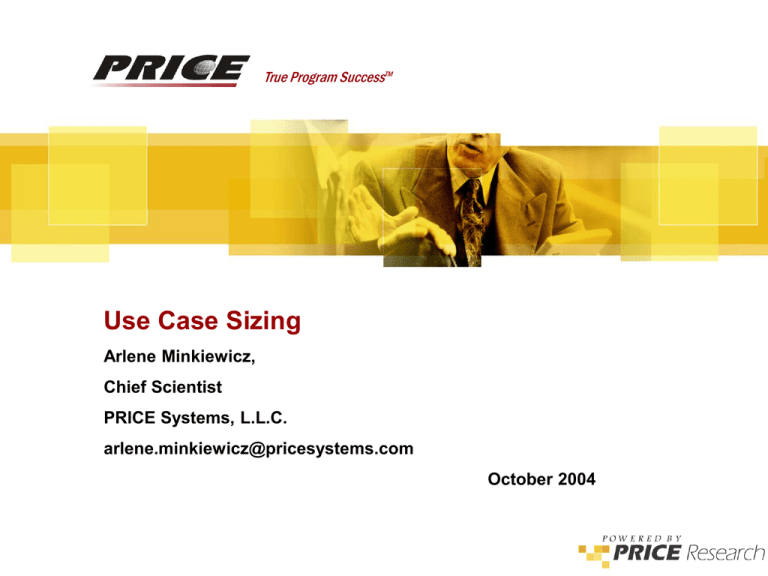
True Program SuccessTM Use Case Sizing Arlene Minkiewicz, Chief Scientist PRICE Systems, L.L.C. arlene.minkiewicz@pricesystems.com October 2004 Use Case Sizing Conclusion 2 > Use Cases have been an effect language for describing requirements of a software system in a way that facilitates communication between developers of software systems and the end users > Use Cases are available before significant architectural and implementation decisions have been made > Use Cases can be an effective measure for estimating software size early on in a software project before enough information is available to estimate size using more traditional measures > Estimates based on use cases alone are not as accurate as those possible after architectural and implementation decisions have been made Use Case Sizing Use Case Sizing 3 1. The Problem – Historical Perspective 2. Solution Methodology 3. Use Cases – What are they and what are they good for? 4. Use Case Conversion Points • Development • Uses 5. Challenges, Limitations and Risks 6. Conclusions Use Case Sizing The Problem – an historical perspective > > > 4 Early cost estimators measured software size in Source Lines of Code (SLOC) – Made sense when projects used similar programming languages and functional characteristics – Third generation languages and functional programming practices – Easy to count and verify with finished software systems Improved software development practices, processes and tools have lead to other more desirable metrics – Function Points – Object Points Today – not only to project managers want metrics more in line with practices and tools, they want to be able to perform estimates earlier in the software lifecycle, before implementation and architectural decisions have been made Use Case Sizing Solution Methodology 5 > Understand and bound the problem > Understand what information is available at the Use Case stage of a project > Identify a verifiable relationship between use case information and an accepted size metric – Function Points > Construct a mathematical model to predict Function Points size from Used Case Information > Test the mathematical model against actual data and refine the model Use Case Sizing Use Cases – What Are They and What Are They Good For? > First Introduced by Ivar Jacobson in the mid 1980’s > Provide a language for software people to effectively communicate with software users – Software Requirements translated to English > Each Use Case Describes a typical interaction that may occur between user and software – User may be a human user or another software system – Focus is on functions users want to perform not on how the system will perform them 6 Use Case Sizing Components of a Use Case > Each Use Case relates to a specific and complete instance of behavior or transaction of the system > Each Use Case is described by – Use Case Name • Describes the goal of the use case • Usually in the form of an ‘action verb + object’ – Actors involved in the specific behavior described • Actors represent the roles that depend on the transaction or that the transaction depends on • Either a person or another software system – Steps in the use case description • List of the things that the software must do to complete the goal of the use case • At a top level these focus on successful satisfaction of the goal • More detailed use cases should follow to account for cases when circumstances prevent success 7 Use Case Sizing Research Details > Detailed use case information available for approximately 20 components > Function Points counts performed by certified function point specialist > Data collected from top level use cases – Number of actors – Complexity of actors – Number of steps in the transaction description 8 Use Case Sizing Research Details > Started with Use Case Points Developed by Gustav Karner > For each Use Case Determined – Complexity of the Use Case as a function of the number of transactions • • • • Simple - <= 3 transactions Average - between 4 and 7 transactions High - between 8 and 13 transactions Extra high - 14 or more transactions > Number of actors per complexity category – Simple actors – External system interfaced through API – Average actors – External system interfaces using text based protocol – Complex actors – End users interfacing through GUI 9 Use Case Sizing Research Details > Assigned weights to Use Case and Actor complexity as follows > Use Cases – Simple = 5 – Average = 10 – High = 15 – Very High = 20 > Actors – Simple = 1 – Average = 2 – Complex = 3 10 Use Case Sizing Research Details > Calculated Use Conversion Points using several different relationships > UCP with actors – = Weighted Use Case + Sum(Weighted Actors) > UCP with no actors – = Weighted Use Case > UCP with simple Actor – Weighted Use Case + Weighted (Actor Average) > Summed the UCP for all use cases associated with a Function Point Count 11 Use Case Sizing Research Details – sample result Name Use Case 1 Use Case 2 Use Case 3 Use Case 4 Use Case 5 Use Case 6 Use Case 7 Use Case 8 Use Case 9 Use Case 10 Use Case 11 Use Case 12 Use Case 13 Use Case 14 Use Case 15 UCP1 10 28 29 29 31 31 43 45 56 59 63 76 88 136 191 UCP2 5 25 20 20 20 25 25 30 30 35 40 70 70 115 115 UCP3 10 28 29 23 29 30 34 36 38 44 51 76 86 120 144 UFP 5 168 49 31 68 102 49 68 79 48 76 98 98 366 247 FP 6 188 54 34 76 115 55 76 89 53 85 109 109 412 277 FUnction Points Vs Use Case Points Function Points 400 350 300 250 Use Cases With Actors 200 150 100 Unadjusted Function Points Software Components 12 Use Case Sizing 15 13 11 9 7 5 3 1 50 0 Research Results > 13 Looking for additional data to extend study Use Case Sizing 300 250 Predicted Function Points 200 150 100 Actual Function Points Software Components 15 13 11 9 7 50 0 5 Currently studying outliers to determine missing factor in calculation 400 350 3 > Not a slam dunk but relationship shows promise Predicted vs Actual Function Points 1 > Relationship Determined for Use Case Points with Actors and Unadjusted Function Points – R-square = 0.6 Function Points > Conclusion 14 > Use Cases have been an effect language for describing requirements of a software system in a way that facilitates communication between developers of software systems and the end users > Use Cases are available before significant architectural and implementation decisions have been made > Use Cases can be an effective measure for estimating software size early on in a software project before enough information is available to estimate size using more traditional measures > Estimates based on use cases alone are not as accurate as those possible after architectural and implementation decisions have been made Arlene F. Minkiewicz Chief Scientist PRICE Systems, L.L.C 856-608-7222 Use Case Sizing Arlene.minkiewicz@pricesystems.com FASTER DECISIONS. BETTER DECISIONS. 15 Use Case Sizing About PRICE Systems > Leader in Program Affordability Management solutions > Combine cost estimating, project control, and knowledge management – ensuring project success at every decision gateway > Customers increase visibility, minimize risk and cost, accelerate project development, and improve the effectiveness of project selection, control and delivery www.PRICESystems.com 16 Use Case Sizing
